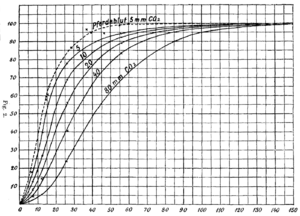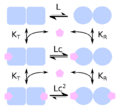Cooperative binding facts for kids
Cooperative binding is a special way that tiny molecules, like oxygen, attach to bigger molecules, like hemoglobin. It means that when one small molecule attaches, it makes it easier or harder for the next one to attach.
This is a type of molecular binding, which is simply when different molecules stick together. They form a stable connection, like a strong hug, and don't break apart quickly.
Contents
How Molecules Work Together
Imagine a big molecule that has a few spots where smaller molecules can attach. With cooperative binding, when the first small molecule attaches, it causes a tiny change in the big molecule. This change then makes it easier for the second, third, and fourth small molecules to attach. It's like opening a door for the others!
A Great Example: Hemoglobin and Oxygen
A perfect example of cooperative binding happens in your body every second. It's how hemoglobin in your blood carries oxygen.
Hemoglobin is a protein found in your red blood cells. Its main job is to pick up oxygen from your lungs and deliver it to all parts of your body.
Oxygen Pickup in the Lungs
When you breathe in, your lungs fill with air that has lots of oxygen. Inside your lungs are tiny air sacs called alveoli. Here, the oxygen concentration is very high.
When hemoglobin molecules reach your lungs, they start picking up oxygen. The first oxygen molecule attaches to a hemoglobin. Because of cooperative binding, this makes it easier for the next oxygen molecules to attach. Soon, each hemoglobin molecule is full of oxygen, forming oxyhemoglobin.
Oxygen Delivery to the Body
The oxyhemoglobin then travels through your bloodstream to different parts of your body, like your muscles. These areas are busy using oxygen, so the oxygen concentration there is much lower than in your lungs.
When oxyhemoglobin reaches these areas, the oxygen starts to detach. Again, cooperative binding plays a role. As one oxygen molecule leaves, it makes it easier for the others to leave too. This way, your body gets the oxygen it needs quickly and efficiently.
Why Cooperative Binding is Important
Cooperative binding is super important for life. It helps your body get enough oxygen to all your cells. Without it, hemoglobin wouldn't be as good at picking up oxygen in the lungs or releasing it where it's needed. It's a clever way nature makes sure your body works perfectly!
Images for kids





